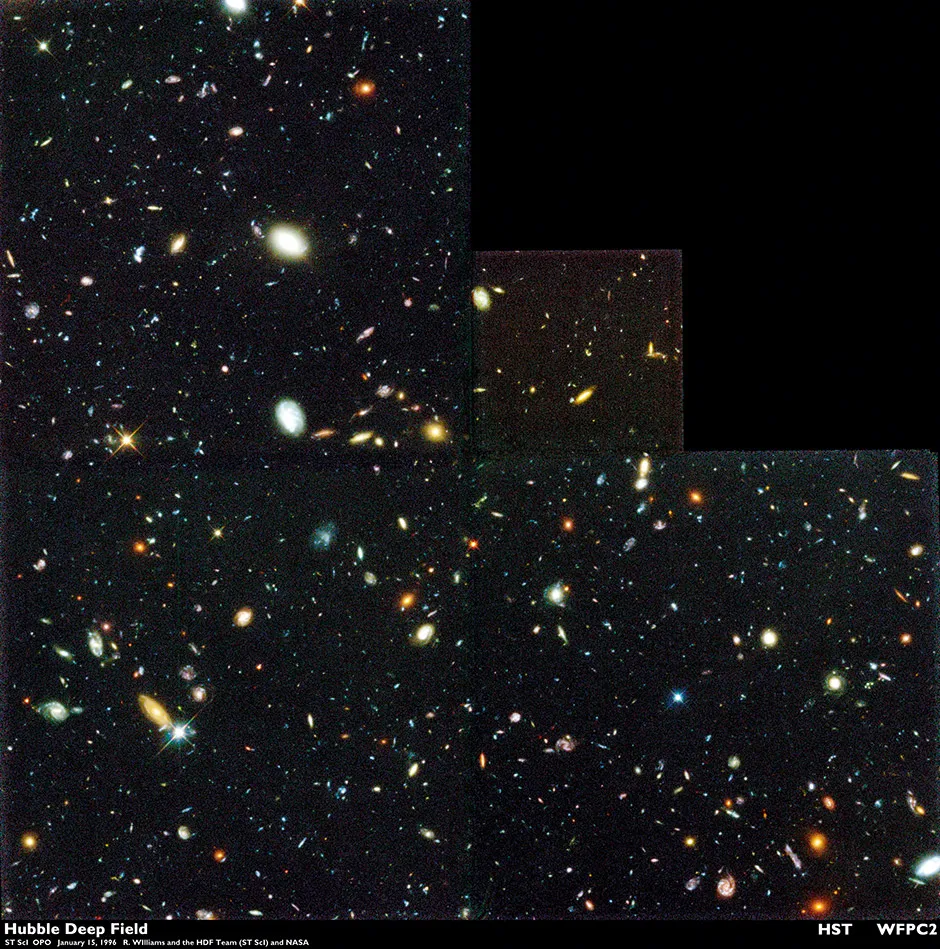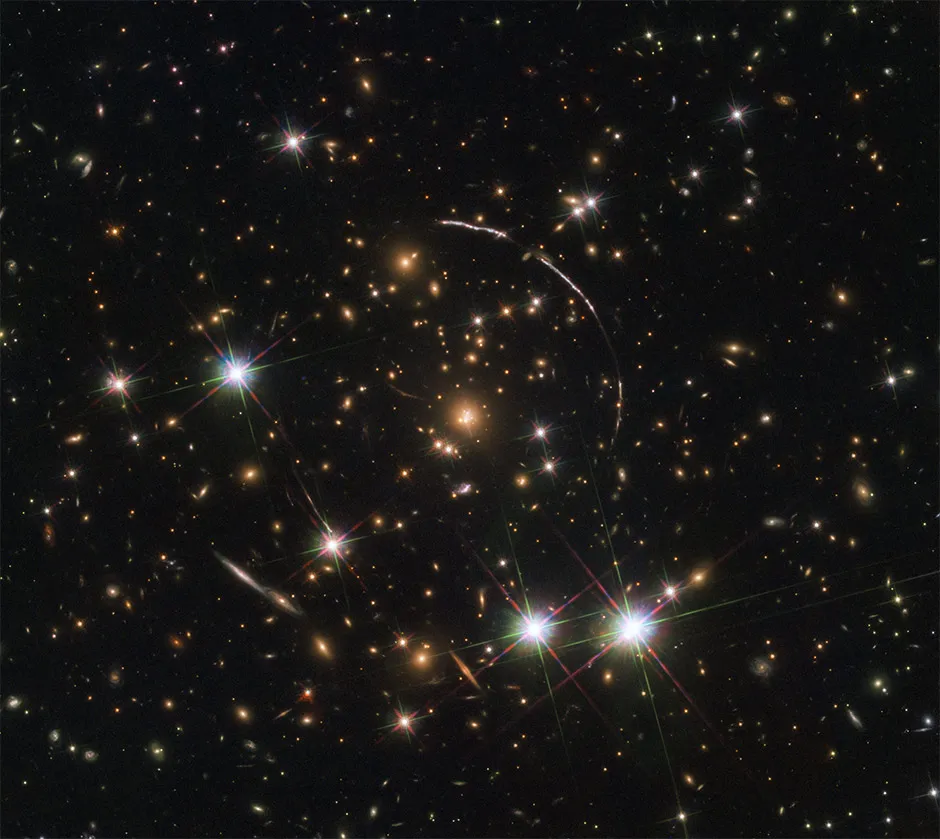The high resolution, large aperture and extreme precision of the Hubble Space Telescope means that it can pull photons out of the darkest reaches of the Universe, looking further back than any visual telescope that came before it.
As the light from these distant galaxies and stars has taken billions of years to cross the void, we see them as they were millennia ago, all the way back to the earliest days of the Universe.
“We can compare the nature of the most distant galaxies to those we see closer to us in space and time, to see if they are different. And, in fact, they are,” says Jennifer Wiseman, Hubble’s senior project scientist. “I think Hubble’s most profound contribution has been revealing to us how the Universe has changed over time.”
Discover more about the Hubble Space Telescope:
- 8 beautiful Hubble Space Telescope images you probably haven't seen before
- Hubble takes us on a journey to the centre of the Galaxy
- 10 of Hubble’s greatest discoveries
- Hubble Space Telescope: "It’s like keeping a laser pointer on a dime 330km away for 24 hours"
- How Hubble gave us a new perspective on the planets
Nowhere is this capability better showcased than in the Hubble Deep Field images. The first of these was taken in 1995, when the telescope took a 100-hour long exposure – many times longer than normal – of an apparently blank stretch of sky.
At the time, some astronomers argued the image was a waste of precious Hubble time, but when the image was put together, they were swiftly proved wrong.
This first image contained almost 3,000 galaxies, some dating back to when the first stars were forming. These appeared to be smaller and more irregular than those in the present day, demonstrating that galaxies do change over time.
Supernovae and dark energy
While Hubble’s keen eye has been able to make out these distant galaxies, it has also been key in working out exactly how far away these remote stellar collectives are.
“Hubble observes the Type Ia supernovae that astronomers use to gauge the distance to far away galaxies,” says Wiseman.
These Type Ia supernovae always explode with the same brightness, so by measuring their apparent brightness from Earth, astronomers can work out how far away they – and the galaxy they occurred in – must be. Calculating these distances is a key part of one of Hubble’s main science goals – measuring the rate at which the Universe is expanding.

“Ever since Edwin Hubble took observations showing galaxies were receding a century ago, we’ve known that the Universe appears to be expanding, and that space seems to be stretching,” says Wiseman.
“But measuring the actual rate of that expansion has been challenging because it requires precise distance measurements. Hubble has helped to make these observations with higher and higher precision, leading to one of its most impactful contributions – realising the Universe’s expansion is actually accelerating.”
Astronomers were surprised when two independent teams discovered this acceleration in 1998. Everyone had assumed that after the Big Bang the expansion would either slow to a stop or plateau to a steady rate. If the expansion is accelerating, then the question arises: what’s speeding it up?
“We still don’t fully understand,” says Wiseman. “It’s a very hot topic in astrophysics. We call it dark energy and Hubble has really played a key role in its study.”
Today, astronomers believe dark energy makes up around 75 per cent of the Universe. A small portion of the rest is made up of luminous matter, such as the gas and dust that glows in clouds or burns in stars. The remaining 24 per cent is dark matter, another mysterious substance which threads through our Universe, extending out between galaxies and stars.
Dark matter and gravitational lensing
This dark matter doesn’t interact with light the way normal matter does, making it completely invisible to normal telescopes. But it does interact with the visible Universe through gravity, meaning that Hubble is able to bring this ‘unseeable’ substance into the light.
“Any type of mass will distort space-time,” says Wiseman. “If you have a very large collection of mass, that distortion might actually create a phenomenon significant enough to be observed.”

This effect is known as gravitational lensing, where light from a distant galaxy is bent by the gravity of a huge object, such as a cluster of galaxies. However, the process isn’t perfect and by the time the light from the distant galaxy reaches Earth it’s usually been badly distorted.
“Hubble is being used to observe clusters of galaxies to detect these arcs of distorted light,” says Wiseman. “By examining the gravitational lensing of the galaxy clusters we can tell something about how mass is distributed in these clusters.”
Most of this mass is dark matter. By looking at how much galaxies are distorted, astronomers are able to map out how the mysterious substance is distributed throughout the Universe.
Spotting supermassive black holes
Another seemingly invisible object that Hubble has helped illuminate are supermassive black holes. These dense bodies are several billion times more massive than our Sun and are thought to lie at the heart of most galaxies.
Before Hubble, these black holes were entirely theoretical. The only evidence of their existence were radio observations of distant galaxies known as quasars, which contained objects around the size of the Solar System but which shone brighter than any other known thing in the Universe.
Read more about cosmology:
- The quest for quantum gravity: why being wrong is essential to science
- Is there a wormhole hiding at the centre of the Milky Way?
Hubble was able to determine that the radio emissions were coming from the centres of the galaxies that held them, most likely from extremely hot gas that was being intensely heated as it swirled around a giant black hole.
In 1997, the Space Telescope Imaging Spectrograph was installed on Hubble. This instrument was much better at looking at the region close to a galaxy’s centre, and it could make out the rapid movement of stars caught in orbit close to a black hole. The instrument soon found them, definitively proving the existence of supermassive black holes.
For the last 30 years, The Hubble Space Telescope has helped astronomers to pull out photons from the deepest depths of space, and even illuminated places in our cosmos where no light shines, helping to reveal the Universe’s darkest secrets.
- This article first appeared in issue 348 ofBBC Science Focus Magazine
From BBC Sky at Night Magazine:
- Hubble at 30: three decades of the famous space telescope
- 'How we serviced Hubble': Mike Massimino reveals all
- How Hubble’s successor the James Webb Space Telescope will observe the Universe
- Astronaut Kathy Sullivan on launching the famous space telescope
- What was wrong with Hubble’s mirror, and how was it fixed?
- Radio Astronomy Podcast: 30 years of the incredible space telescope
- How did the space telescope come about?
- What Hubble's launch meant to me, as an amateur astronomer
- How Hubble changed our view of the Universe
- Why did astronauts service the Hubble Space Telescope?
- How the Hubble Space Telescope is used to study exoplanets
- A history of the Hubble Space Telescope
